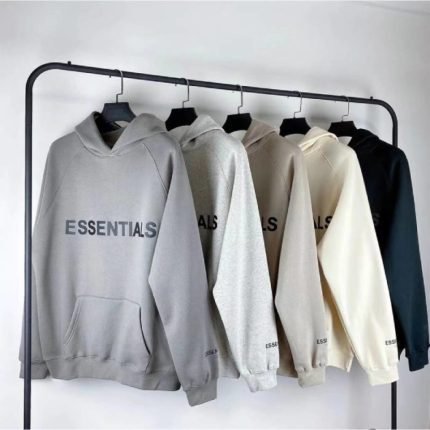Essential Clothing: The Importance of Regular Maintenance
Maintaining your essential clothing is vital for ensuring its longevity, preserving its quality, and keeping it looking fresh and stylish. From your favorite Essential Clothing hoodies and t-shirts to more delicate items, regular maintenance can significantly extend the lifespan of your garments and save you money in the long run. Here’s a comprehensive guide on why regular maintenance is essential and how to implement it effectively.
1. Preserving Quality and Appearance
Regular maintenance helps keep your clothing in top condition:
- Prevents Wear and Tear: Frequent washing, when done correctly, can help prevent dirt and grime from accumulating, reducing the risk of fabric breakdown and wear over time.
- Maintains Color Vibrancy: Washing clothes regularly in cold water with the right detergent can prevent fading and keep colors vibrant. For items with prints or graphics, this is especially important to maintain their appearance.
- Reduces Pilling and Fraying: Regular care, including proper washing and drying techniques, can help minimize pilling and fraying, ensuring that your clothing looks new for longer.
2. Enhancing Comfort
Well-maintained clothing is not only aesthetically pleasing but also more comfortable to wear:
- Odor Control: Regular washing prevents the buildup of sweat and odors, making your clothing more pleasant to wear.
- Prevents Skin Irritation: Clean clothing is less likely to irritate the skin, especially for those with sensitivities. Regular maintenance helps remove allergens and irritants from fabrics.
- Fit and Shape Retention: Proper care helps garments maintain their intended fit and shape. Washing in cold water and air drying can prevent stretching and shrinking.
3. Cost-Effectiveness
Investing time in regular maintenance can save you money:
- Extends Lifespan: By taking good care of your clothing, you can avoid premature replacement, making your wardrobe more cost-effective in the long run.
- Reduces Dry Cleaning Costs: Many essential items can be washed at home, reducing the need for costly dry cleaning services.
- Prevents Damage: Promptly addressing stains and minor repairs can prevent more significant damage, avoiding the need for costly replacements.
4. Sustainability and Environmental Impact
Regular maintenance contributes to a more sustainable lifestyle:
- Reduces Waste: By extending the life of your clothing, you contribute to reducing textile waste. Fewer garments need to be produced, which helps lessen the environmental impact of the fashion industry.
- Saves Resources: Washing in cold water and air drying consumes less energy, which is beneficial for the environment. This practice helps conserve resources and reduce your carbon footprint.
5. Simple Maintenance Practices
Implementing a few simple practices can make regular maintenance easier:
- Establish a Washing Routine: Determine how often to wash your clothing based on usage. Items worn for physical activities may need to be washed more frequently than casual wear.
- Follow Care Labels: Always read and follow the care labels on your clothing for specific washing, drying, and ironing instructions to avoid damage.
- Pre-Treat Stains: Address stains as soon as they occur. Use a small amount of detergent or a stain remover, and let it sit for a few minutes before washing.
- Repair Minor Damages: Learn basic sewing skills to handle minor repairs, such as stitching up small holes or replacing buttons. This can significantly extend the life of your clothing.
6. Proper Storage Techniques
How you store your clothing plays a role in its maintenance:
- Clean Before Storing: Always wash clothing before storing it to prevent stains from setting and to keep pests at bay.
- Use Appropriate Hangers: For items like hoodies and sweatshirts, use padded or wide hangers to prevent stretching. For heavier items, folding them may be better to maintain shape.
- Seasonal Rotation: Rotate your wardrobe seasonally, storing off-season clothing in breathable containers to protect them from dust and moisture.
7. Regular Inspection
Take time to regularly inspect your clothing for any signs of wear and tear:
- Check for Stains: Look for any new stains that may need immediate attention.
- Inspect for Damage: Check seams, hems, and embellishments for any signs of fraying or damage that may need repair.
Conclusion
Regular maintenance of your essential clothing is crucial for preserving quality, enhancing comfort, and promoting sustainability. By implementing simple practices like establishing a washing routine, following care labels, and addressing stains and repairs promptly, you can ensure that your favorite hoodies, t-shirts, and other garments remain in excellent condition. With a little effort and care, your essential clothing will continue to serve you well, keeping you stylish and comfortable for years to come.



